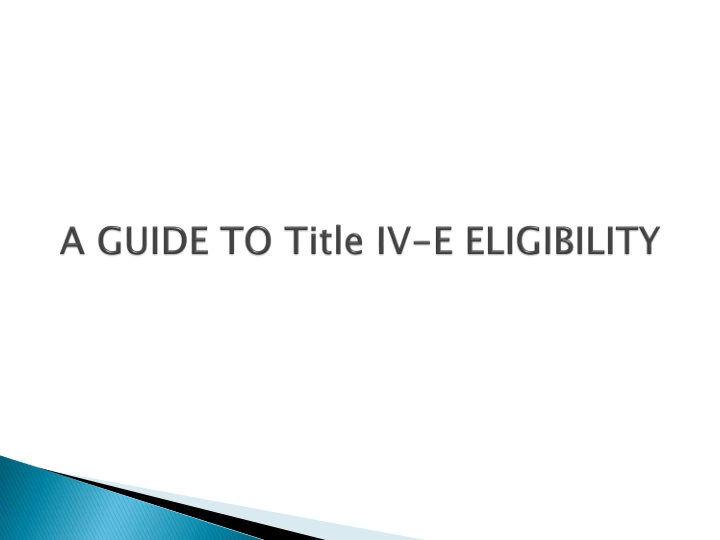



To better understand what IV-E funding is and why it is important to the state of Nebraska and to the children and families we serve To understand Title IV-E funding categories To understand the criteria used to determine IV-E foster care maintenance eligibility
IV-E refers to Title IV-E federal funds that DHHS can receive to help cover: ◦ 51.85% of the Maint ntena nanc nce c costs for State and Tribal Wards who are placed in out of home care when eligibility criteria are met ◦ 50% of the Administr trati tive c costs ts related to IV-E eligible children based on the Random Moment Time Study ◦ 50% to 75% of the Train inin ing c costs related to child welfare case managers
Federal dollars expand the amount of funding available for our child welfare and juvenile services IV-E eligibility may allow for additional benefits for children and families, such as Medicaid in another state, and subsidized adoption payments Federal IV-E money is a critical source of funding for child welfare services
The Three Legged Stool The State Ward Child’s Eligibility 1. The Placement Provider’s Eligibility 2. The Service Eligibility 3.
Title IV-E agencies are required to verify the • citizenship or immigration status of all children receiving Federal foster care maintenance payments, adoption assistance payments, or independent living services. Verification Methods Birth Certificates • Vital Statistics Verification or matches • Automated Narratives • SSI Eligibility • Must be a Qualified Alien Child • (Immigration Documents Required)
Child must have been living in the home of a specified relative during the month of removal; or, Child must have been living in the home of a specified relative within six months of the child’s removal A specified relative may be a parent, or anyone related to the child by blood, marriage, or adoption.
AFDC Eligibility (1996 Standards) Considers Household Size and Income Guidelines Considers Unearned Income (SSI, Unemployment Compensation, Veteran’s Benefits, SSA Disability, etc.) Considers Resource Limit ($10,000.00 or less)
A parent has died A parent has a documented mental or physical incapacity A parent is continually absent from the home The principle wage earner is unemployed or under employed
Items reviewed: Resources Child Support Unearned Income (SSI, SSA)
Physical Removal of the child from the parental or specified relative home A judicial determination must be stated in the initial court order of removal Con Contrary to th to the w welfare of the child to remain in the home; or in the best interests of the child to be removed from the home Nun pro tunc orders are not acceptable
Reason onab able e Efforts ts were made to prevent or eliminate the need for removal of the child from the home; or Reasonable efforts were not necessary prior to removal Reasonable Efforts determination must be made within 60 days of the child’s physical or constructive removal from the parental home.
Once Title IV-E eligibility is established, a judicial determination to the effect that the Title IV-E agency (DHHS) has made reasonable efforts to finalize a permanency plan is required annually to maintain Title IV-E eligibility. Has made reasonable efforts to implement the permanency plan that was in effect during the previous 12 months
To qualify for Title IV-E foster care maintenance payments, the child must be in a foster care placement that meets the standards for full licensure established by the State or Tribe where the foster care placement is located. Placement type examples include foster family homes, group homes, emergency shelter centers, therapeutic group homes, PRTF’s with 25 or fewer children, etc.
Only services related to the maintenance costs of state ward children are IV-E allowable services Maintenance costs are defined as the cost of providing food, clothing shelter, daily supervision, school supplies, child’s personal incidentals, reasonable travel to and from the child’s foster home for visitation with parents or siblings; and travel to and from their home school. Child care is considered daily supervision, and can be claimed, but only when the child is placed in a licensed foster home.
When a state ward child has been returned home for more than six months, a new IV-E eligibility determination must be made A new removal order is required that meets Contrary to the Welfare and Reasonable Efforts to prevent Removal findings.
Recommend
More recommend